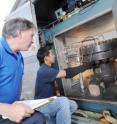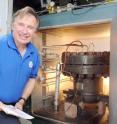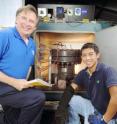Atmospheric simulations will help NASA interpret data from the Juno Mission to Jupiter
Related images
(click to enlarge)
In August of 2016, when NASA's Juno Mission begins sending back information about the atmosphere of the planet Jupiter, research done by Georgia Institute of Technology engineers using a 2,400-pound pressure vessel will help scientists understand what the data means. The Juno probe is scheduled to be launched August 5 from Cape Canaveral Air Force Station in Florida. Because Jupiter has been largely unchanged since its formation at the birth of our solar system, scientists hope Juno will resolve unanswered questions not only about the massive planet, but also about how our solar system evolved. Among the key questions are how much water exists there, and how that water evolved from the hydrogen-rich early solar system.
"Jupiter collected much of the original solar nebula, that sheet of material that surrounded our sun when it formed," said Paul Steffes, a professor in Georgia Tech's School of Electrical and Computer Engineering and a member of the Juno Mission Team. "Knowing how much water is in the atmosphere of Jupiter is going to give us real insight into how the whole solar system has evolved. Understanding Jupiter really helps us understand how we got started."
To detect and measure water, Juno will carry a radiometer that can measure radio emissions produced by the planet itself at microwave frequencies. As those signals pass through Jupiter's atmosphere, they are altered by the water and other constituents. Understanding how the signals were altered can tell scientists much about the atmosphere of the giant planet. The probe will receive microwave signals at six different frequencies that scientists know are emitted at various levels of the planet's atmosphere.
"The intensity of the microwave radiation at specific frequencies gets weaker depending on how much water is there," Steffes explained. "We'll be able to not only say whether or not there's water there, but we'll also be able to say at what altitude it exists based on the signatures of the microwaves coming out of the planet's atmosphere."
Interpreting that data will require knowledge that Steffes and his students are developing by simulating the Jupiter atmosphere in their pressure vessel, which is located inside an oven on the roof of Georgia Tech's Van Leer Building.
Though Jupiter is a long way from the sun, the planet's gravitational forces create high temperatures and tremendous pressures in the lower layers of the atmosphere where the water is believed to exist. The laboratory atmospheric simulations allow Steffes and his students to study the behavior of microwave signals passing through ammonia, hydrogen sulfide, helium, hydrogen and water vapor at pressures up to 100 times those of the Earth.
The researchers, including graduate student Danny Duong, have made thousands of measurements at different temperatures, pressures and microwave frequencies as the signals pass through different combinations of gases. The laboratory work is expected to be completed during 2012.
"The measurements we've made will allow the radiometer on Juno to be calibrated," Steffes explained. "When Juno gets to Jupiter, we'll know what conditions each microwave signature corresponds to."
Earlier attempts to quantify the water on Jupiter – the solar system's largest planet – produced conflicting information. Steffes assisted the Galileo mission, which dropped a probe into the planet's atmosphere in 1995 and found surprisingly little water. Yet when the Comet Shoemaker-Levy crashed into Jupiter in 1994, it stirred up oxygen that led scientists to believe water was abundant.
Once Juno reaches the planet, it will go into an elliptical polar orbit to avoid Jupiter's deadly radiation belts, which would harm the probe's electronic systems. Juno is scheduled to make 30 orbits, each of which will take 11 days. The researchers then expect to take about 18 months to process the information sent back to Earth.
Beyond measuring water on Jupiter, Juno will also study the planet's gravitation field in an effort to determine whether a solid core exists and how the giant body rotates. It will also measure magnetic fields and investigate Jupiter's auroras, which are the strongest in the solar system. And it will take a look at the planet's polar areas for the first time ever.
Juno is also notable because it will be the first deep-space probe to be powered by photovoltaic arrays, which were less expensive than the nuclear generators used on earlier missions.
Steffes has been studying planetary atmospheres for more than 25 years, and has simulated conditions on Venus, Neptune, Saturn and Uranus in addition to Jupiter. The work has continued under the same contract since 1984. Georgia Tech's research into other planets goes back more than 50 years, Steffes noted.
Studies of other planetary atmospheres can now be done from Earth using radio telescopes such as the Very Large Array in New Mexico, or the new Atacama array in Chile. But Jupiter's radiation belts, which are made up of energized particles spewed into the atmosphere by the volcanic moon Io, prevent that.
"To test for water, you have to operate at frequencies that are pretty low, about the same as a cell phone," Steffes said. "But the radiation belts are generating huge amounts of noise at those frequencies, so we couldn't do this observation from Earth because the radiation belts would mask the signal from Jupiter's atmosphere. We are very fortunate to have this opportunity to observe Jupiter with the Juno spacecraft."
Source: Georgia Institute of Technology Research News
Articles on the same topic
- CU-Boulder faculty, students part of NASA's Juno Mission to Jupiter Mon, 1 Aug 2011, 21:04:37 UTC
Other sources
- NASA to Launch Juno Mission to Jupiter Todayfrom Live ScienceMon, 8 Aug 2011, 23:30:59 UTC
- After 'Phenomenal' Launch to Jupiter, Long Wait Begins, Scientists Sayfrom Live ScienceMon, 8 Aug 2011, 23:30:37 UTC
- Video: Juno probe to solve Jupiter's greatest mysteryfrom CBSNews - ScienceSun, 7 Aug 2011, 0:00:32 UTC
- Juno's 5-year trip to Jupiter beginsfrom UPISat, 6 Aug 2011, 16:01:18 UTC
- After 'Phenomenal' Launch to Jupiter, Long Wait Begins, Scientists Sayfrom Space.comFri, 5 Aug 2011, 22:00:28 UTC
- Nasa's Juno lifts off to spy on Jupiterfrom The Guardian - ScienceFri, 5 Aug 2011, 19:00:25 UTC
- NASA's Juno spacecraft launches to Jupiterfrom Science DailyFri, 5 Aug 2011, 18:30:26 UTC
- Juno's 5-year trip to Jupiter beginsfrom UPIFri, 5 Aug 2011, 18:30:23 UTC
- Destination Jupiter: Juno probe lifts offfrom CBSNews - ScienceFri, 5 Aug 2011, 18:00:32 UTC
- NASA's Juno spacecraft launches on journey to Jupiterfrom LA Times - ScienceFri, 5 Aug 2011, 18:00:29 UTC
- NASA launches Juno robot to explore Jupiter's birthfrom Reuters:ScienceFri, 5 Aug 2011, 18:00:20 UTC
- NASA's Juno Spacecraft Launches to Jupiterfrom NASA Jet Propulsion LaboratoryFri, 5 Aug 2011, 17:30:53 UTC
- NASA launches spacecraft on 5-year trip to Jupiterfrom PhysorgFri, 5 Aug 2011, 17:30:42 UTC
- Juno Blast-Off: Jupiter Mission Beginsfrom Space.comFri, 5 Aug 2011, 17:30:36 UTC
- Next Stop, Jupiter! Launch Photos of NASA's Juno Missionfrom Space.comFri, 5 Aug 2011, 17:00:29 UTC
- NASA Launches Spacecraft on Journey to Jupiterfrom Space.comFri, 5 Aug 2011, 16:31:26 UTC
- VIDEO: Nasa Jupiter probe launchfrom BBC News: Science & NatureFri, 5 Aug 2011, 16:01:04 UTC
- NASA probe to Jupiter set to launchfrom CBC: Technology & ScienceFri, 5 Aug 2011, 13:30:36 UTC
- Nasa set to launch Jupiter probefrom BBC News: Science & NatureFri, 5 Aug 2011, 10:30:17 UTC
- NASA poised to launch spacecraft to Jupiterfrom PhysorgFri, 5 Aug 2011, 7:30:20 UTC
- VIDEO: Juno probe to make Jupiter missionfrom BBC News: Science & NatureFri, 5 Aug 2011, 6:00:51 UTC
- NASA to Launch Juno Mission to Jupiter Todayfrom Space.comFri, 5 Aug 2011, 6:00:48 UTC
- Target: Jupiter — Missions to the Solar System's Largest Planetfrom Space.comFri, 5 Aug 2011, 6:00:44 UTC
- Juno Jupiter mission readied for launchfrom UPIFri, 5 Aug 2011, 5:00:40 UTC
- For NASA, Return Trip to Jupiter in Search of Clues to Solar System’s Originsfrom NY Times ScienceFri, 5 Aug 2011, 4:20:10 UTC
- Juno Jupiter mission readied for launchfrom UPIFri, 5 Aug 2011, 2:00:21 UTC
- Juno Mission Hours Away from Planned Launchfrom NASA Jet Propulsion LaboratoryFri, 5 Aug 2011, 1:00:23 UTC
- Target: Jupiter — Missions to the Solar System's Largest Planetfrom Space.comThu, 4 Aug 2011, 22:30:21 UTC
- LEGO Figures Flying On NASA Jupiter Probefrom Space.comThu, 4 Aug 2011, 21:30:25 UTC
- Exploring Jupiter: hurricanes and seas of metallic hydrogenfrom The Guardian - ScienceThu, 4 Aug 2011, 20:31:01 UTC
- NASA's Juno Spacecraft Headed to Jupiter Fridayfrom National GeographicThu, 4 Aug 2011, 20:00:23 UTC
- Juno's mission to Jupiter - videofrom The Guardian - ScienceThu, 4 Aug 2011, 18:00:31 UTC
- Juno space probe prepares for a suicide mission to Jupiterfrom The Guardian - ScienceThu, 4 Aug 2011, 17:30:31 UTC
- NASA's Juno Probe Promises to Send Best Ever Photos of Jupiterfrom Live ScienceThu, 4 Aug 2011, 16:31:20 UTC
- NASA's Juno Mission to Jupiter to Be Farthest Solar-Powered Tripfrom Space.comThu, 4 Aug 2011, 15:31:02 UTC
- Juno spacecraft to carry three figurines to Jupiter orbitfrom PhysorgThu, 4 Aug 2011, 14:01:13 UTC
- Juno Jupiter mission to carry plaque dedicated to Galileofrom PhysorgThu, 4 Aug 2011, 14:01:09 UTC
- Special Florida Events for NASA's Jupiter Probe Launch on Fridayfrom Space.comThu, 4 Aug 2011, 13:00:53 UTC
- Animated Look at Juno's Jupiter Missionfrom Space.comThu, 4 Aug 2011, 2:30:22 UTC
- NASA's Juno Probe Promises to Send Best Ever Photos of Jupiterfrom Space.comWed, 3 Aug 2011, 23:00:37 UTC
- Juno Spacecraft to Carry Three Figurines to Jupiter Orbitfrom NASA Jet Propulsion LaboratoryWed, 3 Aug 2011, 19:31:52 UTC
- Juno Jupiter Mission to Carry Plaque Dedicated to Galileofrom NASA Jet Propulsion LaboratoryWed, 3 Aug 2011, 19:31:52 UTC
- NASA Invites Twitter Followers to Launch of Juno Spacecraftfrom NASA Jet Propulsion LaboratoryWed, 3 Aug 2011, 18:30:52 UTC
- NASA's Jupiter Probe Ready for Launchfrom NASA Jet Propulsion LaboratoryWed, 3 Aug 2011, 18:30:51 UTC
- Simulated atmosphere research to help NASA interpret data from Juno mission to Jupiterfrom Science DailyWed, 3 Aug 2011, 14:30:25 UTC
- Atmospheric Research Supports NASA Mission to Jupiterfrom Newswise - ScinewsWed, 3 Aug 2011, 14:01:43 UTC
- Atmospheric simulations will help NASA interpret data from the Juno Mission to Jupiterfrom PhysorgWed, 3 Aug 2011, 13:31:07 UTC
- NASA's New Juno Mission to Explore Jupiter's Mysteriesfrom Space.comWed, 3 Aug 2011, 13:00:53 UTC
- Juno to show Jupiter's magnetic field in high-deffrom Science DailyWed, 3 Aug 2011, 4:30:35 UTC
- Spacewatch: Juno to Jupiterfrom The Guardian - ScienceTue, 2 Aug 2011, 22:30:50 UTC
- NASA's Juno Mission to Jupiter Poised for Friday Launchfrom Space.comTue, 2 Aug 2011, 18:00:46 UTC
- Juno to Show Jupiter’s Magnetic Field in High-Deffrom Science BlogTue, 2 Aug 2011, 16:01:21 UTC
- Gallery: NASA's Juno Mission to Jupiterfrom Space.comTue, 2 Aug 2011, 13:31:37 UTC
- Mission to Jupiter: Gas giant may hold keys to understanding solar system formation, evolutionfrom Science DailyTue, 2 Aug 2011, 2:30:41 UTC
- Juno to Show Jupiter's Magnetic Field in High-Deffrom NASA Jet Propulsion LaboratoryMon, 1 Aug 2011, 21:30:54 UTC
- Closing in on Jupiter's pastfrom News @ NatureMon, 1 Aug 2011, 19:00:44 UTC
- Closing in on Jupiter's pastfrom News @ NatureMon, 1 Aug 2011, 18:30:47 UTC
- Juno spacecraft prepares to launchfrom PhysorgMon, 1 Aug 2011, 18:00:32 UTC
- NASA going green with solar-powered Jupiter probefrom AP ScienceMon, 1 Aug 2011, 16:00:56 UTC
- NASA's Juno to circle Jupiter for 'planetary recipe'from PhysorgSat, 30 Jul 2011, 9:30:21 UTC
- How NASA's Juno Mission to Jupiter Works (Infographic)from Space.comFri, 29 Jul 2011, 16:01:19 UTC
- Jupiter space probe ready on rocketfrom UPIFri, 29 Jul 2011, 6:30:51 UTC
- Key to Origin of the Solar System to be Probed at Jupiterfrom Space.comThu, 28 Jul 2011, 16:02:02 UTC
- Jupiter-bound Juno spacecraft mated to its rocketfrom PhysorgThu, 28 Jul 2011, 14:30:56 UTC
- Juno's Jupiter mission a quest to find 'recipe for planet-making'from PhysorgThu, 28 Jul 2011, 14:01:24 UTC
- NASA probe poised for launch to Jupiterfrom Reuters:ScienceThu, 28 Jul 2011, 13:20:12 UTC
- Jupiter space probe ready on rocketfrom UPIThu, 28 Jul 2011, 2:20:11 UTC
- Juno's Jupiter mission may yield clues to Earth's originsfrom LA Times - ScienceThu, 28 Jul 2011, 2:00:16 UTC
- NASA probe poised for launch to Jupiterfrom Reuters:ScienceWed, 27 Jul 2011, 21:00:17 UTC
- NASA Set to Launch Spacecraft Towards Jupiter Next Weekfrom Space.comWed, 27 Jul 2011, 20:32:13 UTC
- Jupiter-bound spacecraft readies for launchfrom CBC: Technology & ScienceWed, 27 Jul 2011, 20:00:26 UTC
- NASA's Jupiter-bound Juno spacecraft mated to its rocketfrom Science DailyWed, 27 Jul 2011, 19:30:32 UTC
- NASA's Jupiter-Bound Juno Spacecraft Mated to its Rocketfrom NASA Jet Propulsion LaboratoryWed, 27 Jul 2011, 18:31:08 UTC
- NASA Sets Launch Coverage Events For Mission to Jupiterfrom NASA Jet Propulsion LaboratoryWed, 27 Jul 2011, 0:00:21 UTC
- 7 Rocket Launches in 7 Daysfrom Space.comSun, 24 Jul 2011, 19:30:28 UTC


